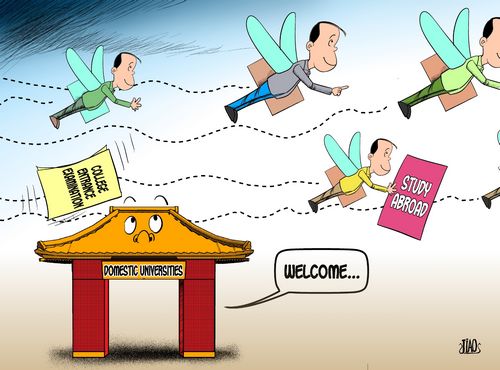Learning to be more like each other
- By Ma Yingyi
 0 Comment(s)
0 Comment(s) Print
Print E-mail
China.org.cn, January 23, 2012
E-mail
China.org.cn, January 23, 2012
Today, we are faced with the fascinating paradox which sees Chinese students flocking to American schools and universities in the belief that the American education system is superior; whilst American educators and the public deplore the problems with their own education system and are looking to China in order to seek a better education for their children. This search is principally a result of the considerably higher test scores of Chinese students in international assessments.
|
|
|
Snubbed [By Jiao Haiyang/China.org.cn] |
The documentary "Two Million Minutes" has been shown in many American schools and sparked heated debate about whether or not standards in American education have fallen behind those of other countries, particularly China. This documentary, produced by Robert Compton, followed a total of six high school students, two each from China, India and the U.S., and documented how they spent their high school time. The film highlights the fact that American students spend far less time than their Chinese and Indian counterparts studying core academic subjects and more time socializing and taking part in extracurricular activities. This film, coupled with consistent findings detailing the poor performance of American students in international testing, has led many to express concern about both the American education system and America's future leadership role in the world.
"Two Million Minutes" pointed out the difference between how much time American high school students put into their studies compared with their Chinese and Indian counterparts. Of course, people will interpret these findings differently, according to their perspectives. If we accept the Chinese model as the standard, then American students spend too little time on their studies; and vice versa. Both systems clearly have their problems, so it may be unwise to use either as a model. My proposition is that, as both systems go to extremes, they should aim for balance by learning from each other and converging towards each other.
In order to assess how the two systems could learn from each other, we need to understand the strength and weaknesses of both. The American system emphasizes individuality and diversity in learning. It values creativity over conformity, and eschews rote memorization and drill learning. Students in the American education system are encouraged to have fun while learning. They are taught that the pursuance of individual interests is paramount. While some applaud American system for its ability to produce creative outstanding talents, I argue that creativity is sometimes contingent upon solid foundations. Some subjects, particularly math and science, require that students do exercises, which might not be entirely fun, in order that they build a solid foundation for future learning. Those without a solid training during elementary and secondary schools may risk losing the capacity to utilize their creativity in math and science-related subjects in college. Psychologically, students are often defeated before they even get to college, having already decided that math is not for them. Subsequently, they opt out of any math and science related courses in college. This is evidenced by the low achievement levels of average American students in math and science, and the low proportion of American undergraduate students majoring in science, technology, engineering and math (STEM) fields. It is ironic that, in a tight job market, STEM majors are very marketable in America.
By contrast, the Chinese education system emphasizes exercises and testing. Students of the same grade level are expected to learn the same materials and are constantly evaluated by a range of different tests. Those who struggle must generally do more exercise to catch up. They are pushed by parents and teachers, who have high expectations for them. Such expectations and common standards mean that most Chinese students are hardworking and resilient and see education as arduous rather than fun. Math and science subjects are linked with modernization goals and thus highly valued in China. Not surprisingly, about half of all first degree awarded in China are in STEM subjects. Some of those graduates actually come to the U.S., either for graduate study or to take technology industry jobs left unfilled by Americans.
However, China's policy makers and academics criticize the Chinese education system for being too test-oriented. Many in China are worried that their education system is unable to produce outstanding creative talents. Qian Xueseng, a Chinese rock scientist and educator, raised a question which resonated so much that it was quoted by Premier Wen Jiaobao at the annual central government meeting: "Why, despite the fact that it produces the highest number of college graduates in the world, can China not produce top-notch creative talents?" In similar vein, why, despite providing millions of workers for American tech companies, can China not produce a Steve Jobs or Bill Gates of its own?
Perhaps China can adopt and emulate elements of the American educational philosophy. Creativity is a key part of the makeup of outstanding talents, and curiosity and an interest in learning for its own sake rather than for external evaluations (i.e. testing) is more sustainable and likely to yield long-term benefits for both individuals and society. However, learning also requires hard work, and cannot always be fun. This is unfortunately not fully recognized and emphasized in the American education system, particularly during pre-college education. This has contributed to the lack of rigor and solid training, something which the American education system can certainly learn from China.
Ma Yingyi is currently an Assistant Professor in Sociology at Syracuse University's Maxwell School of Citizenship and Public Affairs. She is also an affiliated faculty member with the Women's Study Department and the program of Asia/Asian American. She obtained her PhD in Sociology at Johns Hopkins University in 2007. Her work explores issues of social inequality related to education, gender and migration.






